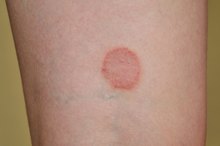How to Kill Ringworm With Bleach
Ringworm is a highly contagious fungal infection that develops on the top layer of skin 3. It has nothing to do with an actual worm; the name comes from the circular lesion that develops at the site of infection. Symptoms of ringworm include itching and redness 3. Other forms of fungal infection closely related to ringworm impact other areas of the body 3. Treatment usually requires an oral or topical anti-fungal medication. Home treatment may be attempted using liquid bleach, but there are risks associated with applying bleach to the skin.
If you are experiencing serious medical symptoms, seek emergency treatment immediately.
Dilute liquid bleach in a clean glass or container with equal parts bleach and water. Take care not to spill or drip the strong solution.
Use of Clorox in Treating Ringworm
Learn More
Dip a cotton ball or swab into the solution. Gently dab the ringworm area with the solution 3. Avoid the surrounding skin. Allow the area to dry.
Do not rinse the bleach solution from the area unless you feel discomfort.
How to Remove Chlorine From the Hair & Body
Learn More
Wash the area with warm soap and water the next day and administer another application of the bleach solution. Wait until the next day to see if the ringworm is gone 3. If the bleach treatment does not work, contact your doctor or purchase an over-the-counter anti-fungal cream that is safe for ringworm treatment 3.
Consult your veterinarian before applying a bleach mixture to an animal. Some animals may not tolerate the mixture or could suffer serious health problems from the bleach.
Warnings
Liquid bleach is a potent chemical that can be hazardous to your health. The manufacturer recommends using soap and water to remove bleach on the skin, as it can cause harmful reactions. Using liquid bleach to treat ringworm does not adhere to the warnings and precautions listed on the bottle.
Related Articles
References
- Clorox for Germ and Fungus Treatment
- Ringworm of the Body
- Benzoni T, Hatcher JD. Bleach Toxicity. In: StatPearls [Internet]. 2019.
- Benzoni T, Hatcher JD. Bleach Toxicity. In: StatPearls [Internet]. 2019.
- Center for Disease Control and Prevention. Cleaning and sanitizing with bleach after an emergency. Health and Safety Concerns for All Disasters. 2017.
- Centers for Disease Control and Prevention. Infection Control: Chemical disinfectants. Updated September 18, 2016.
- Centers for Disease Control and Prevention. Cleaning and Sanitizing With Bleach After an Emergency.
- E. Rhinehart, M. Friedman, and M. McGoldrick. Infection Control in Home Care and Hospice. 2006. Association for Professionals in Infection Control and Epidemiology. Jones and Bartlett Publishers.
Writer Bio
Sarah Harding has written stacks of research articles dating back to 2000. She has consulted in various settings and taught courses focused on psychology. Her work has been published by ParentDish, Atkins and other clients. Harding holds a Master of Science in psychology from Capella University and is completing several certificates through the Childbirth and Postpartum Professional Association.









